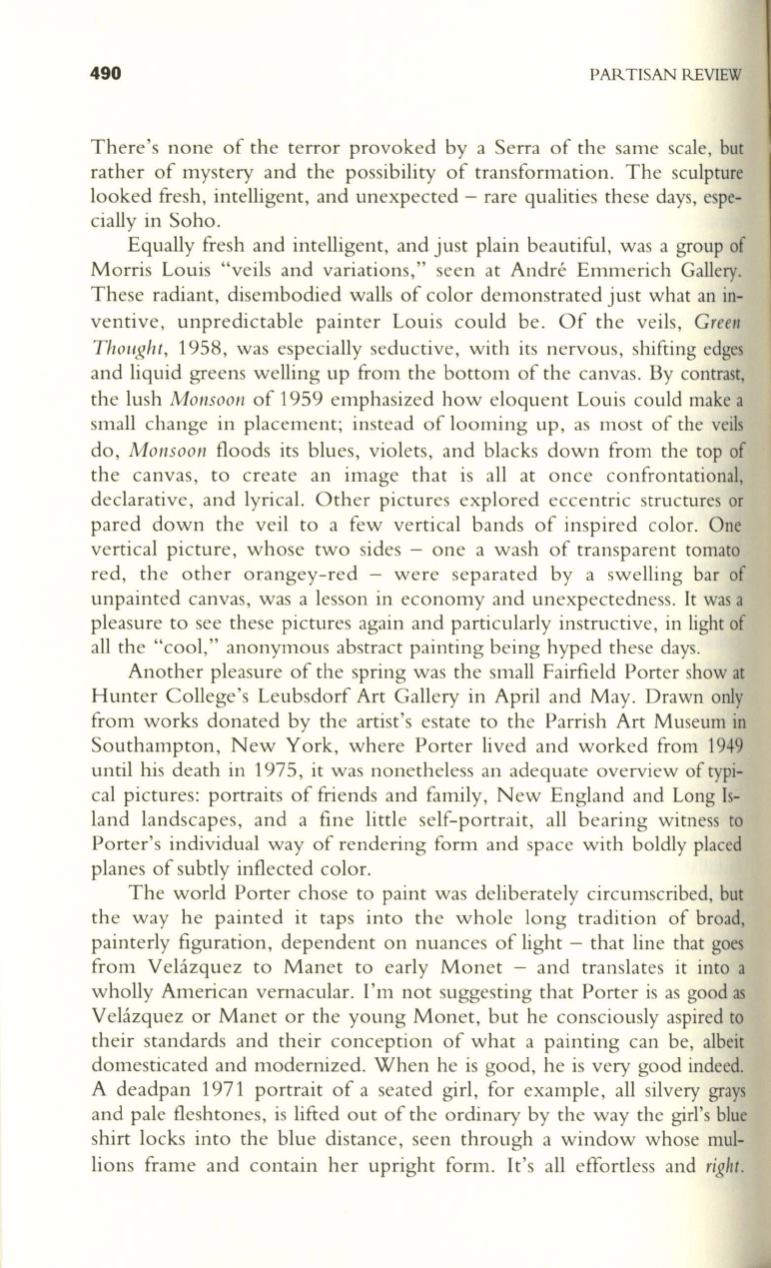
490
PARTISAN REVIEW
There's none of the terror provoked by a Serra of the same scale, but
rather of mystery and the possibility of transformation. The sculpture
looked fresh, intelligent, and unexpected - rare qualities these days, espe–
cially in Soho.
Equally fresh and intelligent, and just plain beautiful, was a group of
Morris Louis "veils and variations," seen at Andre Emmerich Gallery.
These radiant, disembodied walls of color demonstrated just what an in–
ventive, unpredictable painter Louis could be. Of the veils,
Cree"
Thought,
1958, was especially seductive, with its nervous, shifting edges
and liquid greens welling up from the bottom of the canvas. By contrast,
the lush
Monsoon
of 1959 emphasized how eloquent Louis could make a
small change in placement; instead of looming up, as most of the veils
do,
Monsoon
floods its blues, violets, and blacks down from the top of
the canvas, to create an image that is all at once confrontational,
declarative, and lyrical. Other pictures explored eccentric structures or
pared down the veil to a few vertical bands of inspired color. One
vertical picture, whose two sides - one a wash of transparent tomato
red, the other orangey-red - were separated by a swelling bar of
unpainted canvas, was a lesson in economy and unexpectedness. It was a
pleasure to see these pictures again and particularly instructive, in light of
all the "cool," anonymous abstract painting being hyped these days.
Another pleasure of the spring was the small Fairfield Porter show at
Hunter College's Leubsdorf Art Gallery in April and May. Drawn only
from works donated by the artist's estate to the Parrish Art Museum in
Southampton, New York, where Porter lived and worked from 1949
until his death in 1975, it was nonetheless an adequate overview of typi–
cal pictures: portraits of friends and family, New England and Long Is–
land landscapes, and a fine little self-portrait, all bearing witness to
Porter's individual way of rendering form and space with boldly placed
planes of subtly inflected color.
The world Porter chose to paint was deliberately circumscribed, but
the way he painted it taps into the whole long tradition of broad,
painterly figuration, dependent on nuances of light - that line that goes
from Velazquez to Manet to early Monet - and translates it into a
wholly American vernacular. I'm not suggesting that Porter is as good as
Velazquez or Manet or the young Monet, but he consciously aspired to
their standards and their conception of what a painting can be, albeit
domesticated and modernized. When he is good, he is very good indeed.
A deadpan 1971 portrait of a seated girl, for example, all silvery grays
and pale fleshtones, is lifted out of the ordinary by the way the girl's blue
shirt locks into the blue distance, seen through a window whose mul–
lions frame and contain her upright form. It's all effortless and
right.


